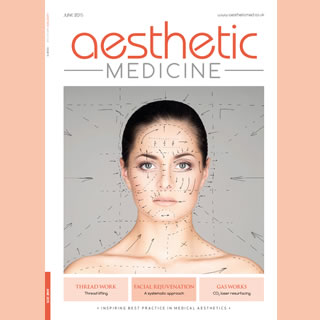
12 June Up Lifting
Dr Charlotte Woodward and Dr Victoria Manning from River Aesthetics talk about the PDO Breast Lift procedure
PDO thread lifts are the latest and revolutionary treatment for skin tightening and lifting, as well as V-shaping the face. However now, we can use threads, to produce impressive breast lifts. Although not suitable for all, this treatment now offers a quick, alternative to going under the knife.
The threads are made of PDO (polydioxanone) material, which is used for surgical stitches. PDO continuously stimulates collagen synthesis under skin, which means the results improve over time. When inserted into the skin, they act as a “scaffold” for the skin that helps to “hold” the skin against the effects of gravity. The threads are absorbable and therefore will be reabsorbed in four to six months, leaving nothing behind but the skin structure created which continues to hold for another 18-24 months.
It is important to understand the anatomy of the breast in order to not only reduce complications but also understand how the procedure actually works.
The breast is an organ, the structure of which reflects its special function: the production of milk for lactation. The epithelial component of the tissue consists of lobules, where milk is made, which connect to ducts that lead out to the nipple. These lobules and ducts are located throughout the background fibrous and adipose tissue that make up the main mass of the breast.
Anatomically, the adult breast sits atop the pectoralis muscle, over the ribcage. The breast tissue extends horizontally from the edge of the sternum out to the mid-axillary line. The breast tissue is encircled by a thin layer of connective tissue called fascia. The deep layer of this fascia sits immediately on top of the pectoralis muscle, and the superficial layer sits just under the skin. The fascial relationships of the breast are of practical importance, the gland lies in a pocket of superficial fascia, both deep and superficial layers. The superficial layer lies immediately beneath the dermis and enables injections and implantations of threads avoiding the glandular mass and in a relatively avascular plane. The deeper fascia is thicker and covers deep aspect of breastplate and beneath this sheath is a layer of thin areolar tissue. Fibrous processes of this fascia extend up to the skin and to the nipple. They are more developed over the upper part of the breast, where they form suspensory ligaments of Cooper. It is the contraction of these ligaments that will give the lift. The supporting ligaments of Cooper maintain the tone and shape of the breasts and when healthy, keep the breasts firm and tight on the body. They can lengthen and weaken over time, especially when tension is lost as a person ages. Breast-feeding and injuries can affect the ligaments as well, causing the breasts to droop and elongate, so any changes in the ligaments can have a drastic effect on physical appearance.
The Procedure
A thorough medical history and a full analysis of the breasts is taken to assess patient suitability. The breast examination is paramount to check for any lumps, skin changes or tethering of the breast tissue.
The patient is treated lying down and the breasts are taped together. The area is cleaned and thoroughly disinfected using chlorhexidine. Concentrating around the areolae where bacteria harbour themselves in the Tubercles of Montgomery.
Depending on the degree of tissue laxity the amount of threads vary, however a standard breast would take 20- 25 Newton spiral cogs inserted with a 21G 90mm cannula.
Each entry point is anaesthetised with local anaesthetic and adrenaline and takes two cogs per entry portal. With the innovative technology adopted by the PDO thread lift,
side effects and downtime are only limited to manipulation techniques of the practitioner.
At River Aesthetics we cover both our facial and breast lifts with a three day course of Azithromycin.
What are the benefits to the patient?
- Instant and long lasting results for up to two years
- The procedure stimulates collagen production – improving
tissue elasticity - Stimulation of new blood vessels which improves oxygen
supply to skin - Fibroblast stimulation – improving skin texture and tone
- Reducing pore size due to new tissue formulation
- A quick and easy procedure, ensuring minimal downtime and
discomfort
Is this a painful treatment?
The procedure does involve mild discomfort, some bleeding and post procedural bruising for up to 10 days after.
When does the effect appear and how long does it last?
The first effects are visible instantly, but considerable improvement appears after two to three months, when induction of new collagen begins.
Post-treatment recommendations
There are no contraindications against returning to the patient’s daily activity. Reddening at the thread introduction spots disappear three to five hours after the treatment. We tape the breasts for 48 hours post procedure for best results & advise wearing a supportive bra for two weeks post treatment. Adverse effects Post procedural bruising and discomfort are common side effects.
Sometimes if threads are placed too superficially they may need hydro-dissection to lift the skin from them to avoid puckering.
Contraindications
- Past or current history of breast cancer
- Pregnancy and breastfeeding
- Bleeding disorders
- Fear of needles
- Body dysmorphia
- Patients with unrealistic expectations
Dr Charlotte Woodward MBchB MRCGP qualified Leicester University Medical School in 1991 partner in General Practice for past seven years and is now a full time director at River Aesthetics. She has eight years cosmetic experience.
Dr Victoria Manning BM DFFP qualified Southampton University in 1996 completed post grad training at St Mary’s Hospital, Paddington before sharing time between General Practice and cosmetic medicine. She is now full time director of River Aesthetics in the New Forest



